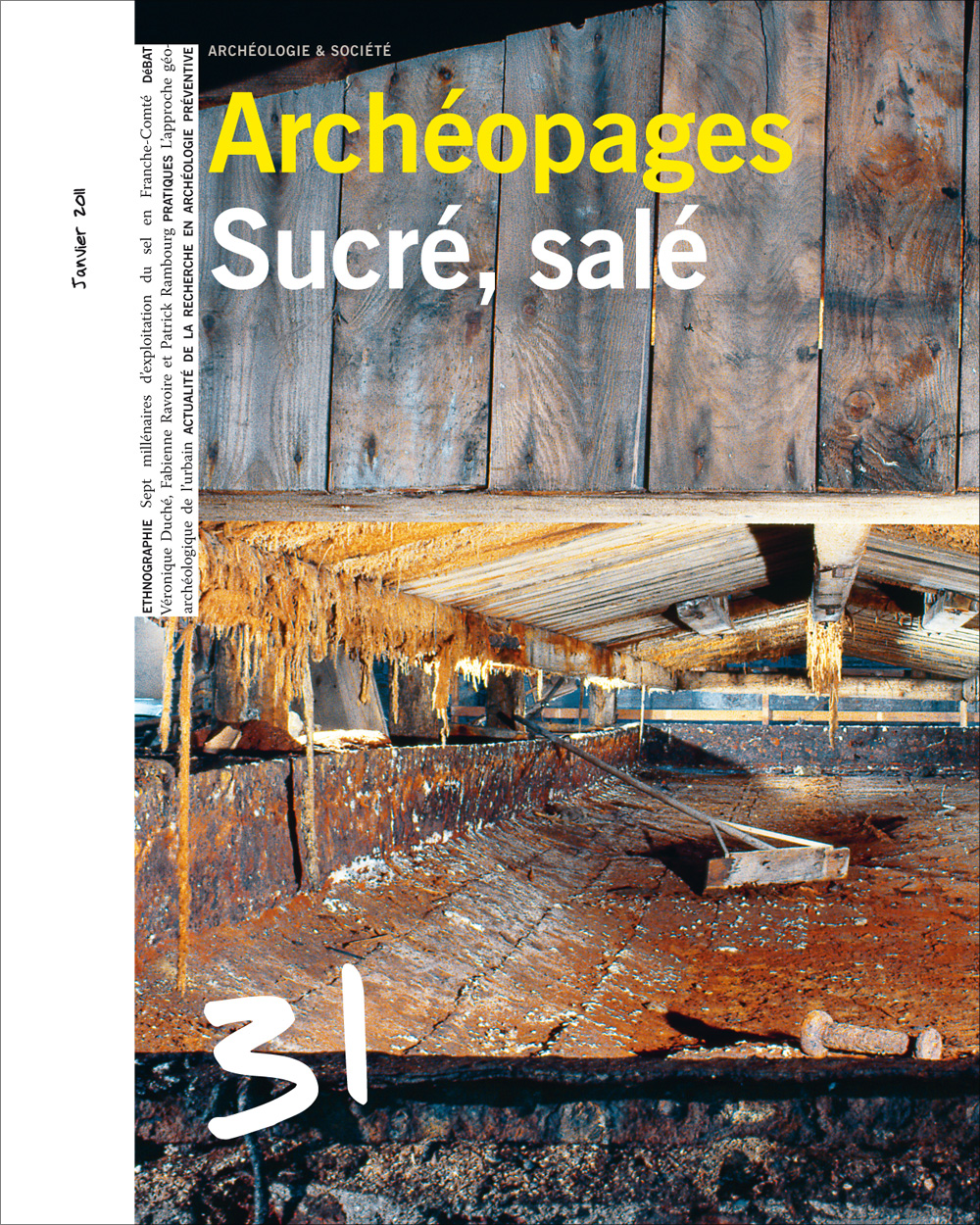You are here
Archéopages 31 - Sweet and salty
To base itself on archaeology in order to rethink our ways of living together in one environment: Such is the editorial line of Archéopages, a scientific journal with a review panel. Each issue develops a specific theme by crossing the points of view of archaeologists of all backgrounds and those of other researchers in human sciences, thus taking stock of the recent contributions of archaeology to the knowledge of societies. A large space is also devoted to modern methods of archaeology. The journal is aimed at researchers, students and enlightened amateurs.
Archaeology is not stingy with testimonies on the production of salt and sugar. To obtain these two essential products, men have competed with technical ingenuity, both domestically and in trade.

Editorial
Jean-Paul Jacob
File: Sweet and salty
A Pyrenean salt-exploitation site occupied since protohistory. The Collège des Trois Vallées site and the Fontaine Salée at Salies-du-Salat
Jean-François Chopin
West Salt Story. The salt production sites of coastal Charente
Patrick Maguer, Guilhem Landreau, Léa Martignole
The salt ages in northern Gaul. Some marine salt-producing sites of the La Tène and Gallo-Roman periods
Gilles Prilaux, Cyrille Chaidron, Frédéric Lemaire, Armelle Masse
Box 1: Salt production from archaeological examples - Cyrille Chaidron
Box 2: A Gallic salt workshop in the hinterland - Armelle Masse
Honey production in medieval and modern times. Towards an "archaeology of honey”
Catherine Mousinho
Box: The "Bee House" in Alzon (Gard) - Laurent Vidal et Hervé Petitot
The production of sugar moulds in Guadeloupe and Martinique. The contribution of archaeology to the documentary record
Tristan Yvon, Fabrice Casagrande
Box: A candy factory from the second half of the 17th century in the Basse-Terre region - Fabrice Casagrande
Archaeology and sugar refining at La Rochelle in the 17th and 18th centuries. A preliminary overview
Éric Normand
Box: Petrographic analysis of refined ceramics - Sébastien Pauly
The production of sugar at Marseille. An archaeological contribution
Véronique Abel
Box: Another way to perceive sugar, the birth of the cup in Marseille
Seven millennia of salt exploitation in Franche-Comté - The salt works at Salins les Bains
Philippe Mairot
Debate - The values of flavors
Véronique Duché, Patrick Rambourg, Fabienne Ravoire
Practical
A geoarchaeological approach to the urban fabric. Theory, methodology and application in archaeological interventions
Cécilia Cammas, Quentin Borderie, Bruno Desachy, Stéphane Augry
Box 1: Sites and monuments record and the original site of Lille - Laurent Deschodt
Box 2: Observations on the alluvial site of Strasbourg - Nathalie Schneider
Sidebar 3: Geomorphology and human settlement: the example of Toulouse - Laurent Bruxelles
Box 4: Paris and data management using GIS - Pascal Raymond et Mehdi Belarbi
Box 5: The urban "black earth” of the Early Middle Ages - Quentin Borderie, Mélanie Fondrillon, Cécilia Cammas, Bruno Desachy, Christian David
Box 6: Soil, humanly-modified soil, urban soil… or how to avoid terminological ambiguity - Quentin Borderie, Cécilia Cammas, Bruno Desachy, Kaï Fechner
News
Halle linked to Champagne Fair?
Julien Avinain
Roman floors polychrome
Véronique Blanc-Bijon, Philippe Mellinand
Revue « Archéopages : archéologie & société », 31
January 2011
Size 22 x 27,5 cm
104 pages
ISSN: 1622-8545
To subscribe or purchase a number, contact the publisher (Éditions Faton):
Librairie archéologique
CS50090 - 1, rue des artisans
21803 Quétigny cedex
Phone: +33 3 80 48 98 60
infos [at] librairie-archeologique.com
Catherine Chauveau
Cultural Development and Communication Department, Inrap
Editor in Chief
Phone: +33 1 40 08 81 44
catherine.chauveau [at] inrap.fr

